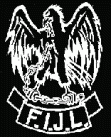Libertarian Youth

The Iberian Federation of Libertarian Youth[1] (FIJL, Spanish: Federación Ibérica de Juventudes Libertarias), sometimes abbreviated as Libertarian Youth (Juventudes Libertarias), is a libertarian socialist[2] organisation created in 1932 in Madrid.[3] It exists to this day.
History
The FIJL was created in 1932 in Madrid.[3] In February 1937 the FIJL organised a plenum of regional organisations (second congress of FIJL). In October 1938, from the 16th through the 30th in Barcelona, the FIJL participated in a national plenum of the libertarian movement, which was also attended by members of the Confederación Nacional del Trabajo (CNT) and the Iberian Anarchist Federation (FAI).[4]

During the purge of the Workers' Party of Marxist Unification (POUM) and other dissident organisations, which took place in Barcelona towards the end of the Spanish Civil War, many FIJL members were murdered by those acting under Joseph Stalin's orders.[5] After the Civil War, FIJL acted in two branches: one in exile in Paris, and one secret and illegal domestic organisation under Franco's regime. Some FIJL members were associated with the militant First of May Group.[6] FIJL was banned in France in 1963.[7]
The organisation's most famous member was Federico Borrell García, the subject of Robert Capa's most well known photograph, The Falling Soldier. The image, taken in 1936, depicts the moment of García's death during the Spanish Civil War.

Contemporary developments
During the early 2000s, the FIJL started to evolve towards insurrectionist positions and its differences with anarcho-syndicalism became more evident; this was due to the influence of the Black block in alterglobalization protests and the influence of developments on from Italy and Greece. Following this it suffered a period of significant state repression, resulting in inactivity.[8]
In 2006, a new generation of anarchist youth decided to establish a new FIJL. The new organisation differentiated itself from the insurrectionist FIJL, defending anarcho-syndicalism critically.[9] In 2007, after a period of no communication from the original FIJL, the new group re-established itself as the FIJL, but upon learning of a communique by the insurrectionist organization[8] named itself "Iberian Federation of Anarchist Youth" (FIJA, Spanish: Federación Ibérica de Juventudes Anarquistas), but claimed to represent the ideological heritage of the FIJL.[10] They publish a newspaper called El Fuelle.
In March of 2012 the insurrectionist FIJL disbanded,[11] prompting FIJA to once again claim the name.[12] Today, this FIJL has a presence in Asturias, Cádiz, Donosti, Granada, Lorca (Murcia), and Madrid.[13]
References
- ^ The FIJL is referred to as the "Iberian Federation of Libertarian Youth" in, inter alia:
- George Richard Esenwein, The Spanish Civil War: a Modern Tragedy, 2005, p 269.
- Alexandre Skirda, Facing the Enemy: a History of Anarchist Organization from Proudhon to May 1968, 2002, p 158.
- Peter Marshall, Demanding the Impossible: A History of Anarchism, 2010, p 466.
- Graham Kelsey, Anarchosyndicalism, Libertarian Communism, and the State: the CNT in Zaragoza and Aragon, 1930-1937, 1991, p 250.
- ^ José Peirats & Chris Ealham, The CNT in the Spanish Revolution, Volume 2, 2001, p. 76. "The anarchist youth movement had been founded soon after the birth of the Second Republic.... Later, they spread throughout the whole of Spain until they came to represent the third branch of the great libertarian family.... The FIJL had agreed upon the following statement of principles: '...This Association shall strive to invest young people with a libertarian conviction, as to equip them individually to struggle against authority in all its forms, whether in trade union matters or in ideological ones, so as to attain a libertarian social arrangement'"
- ^ a b Esenwein, p.269
- ^ Gómez Casas, p.237
- ^ Beevor(1982) The Spanish Civil War, London, Cassell, p. 275; photograph p.304.
- ^ Meltzer, Albert (1996). I Couldn't Paint Golden Angels. Edinburgh: AK Press. ISBN 1-873176-93-7.
- ^ Alted Vigil, Alicia, and Lucienne Domergue. El exilio republicano español en Toulouse (1939 - 1999). Madrid: Univ. Nacional de Educación a Distancia, 2004. p. 116
- ^ a b Comunicado de la FIJL
- ^ Juventudes Anarquistas de León, "La Teoría de Cuerdas del Sindicalismo" http://www.nodo50.org/juventudeslibertarias/?e=5 o Grupo Bandera Negra "Lo que es y no es el 19 de julio" http://grupobanderanegra.blogspot.com.es/2011/07/lo-que-es-y-no-es-el-19-de-julio_19.html
- ^ "Nace la Federación Ibérica de Juventudes Anarquistas". alasbarricadas.org. 11 August 2007. Retrieved 3 February 2014.
- ^ Comunicado de disolución de la Federación Ibérica de Juventudes Libertarias (FIJL)
- ^ "Federación Ibérica de Juventudes Libertarias – F.I.J.L". nodo50.org. 5 April 2012. Retrieved 3 February 2014.
- ^ Directorio de la Federación Ibérica de Juventudes Libertarias
Sources
- Esenwein, George Richard. The Spanish Civil War: A Modern Tragedy, Routledge, 2005.
- Gómez Casas, Juan (1986). Anarchist Organisation: The History of the F.A.I., Black Rose Books Ltd., ISBN 0-920057-38-1.
